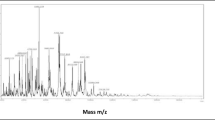Abstract
Pseudomonas aeruginosa strains that produce metallo beta lactamases (MBLs) are becoming increasingly prevalent in wound infections. The aim of the present study is to determine the clinical features, incidence, and to find out the antimicrobial susceptibility pattern of Pseudomonas aeruginosa in diabetic foot infections. Pus samples for bacterial culture were collected from 310 patients admitted with diabetic foot infections. Antimicrobial sensitivity testing was performed by the Kirby-Bauer disc diffusion method. Carbapenem resistance screening and confirmation of MBL was done by the modified imipenem-ethylenediaminetetraacetic acid (EDTA) double disc synergy test. A total of 54 Pseudomonas aeruginosa was isolated from 310 diabetic foot cases. Males were affected more than females with an M:F ratio of 1.6:1. Most patients belonged to the fifth decade of life with a mean age of 49 ± 16.8 years. All the patients were previously diagnosed with diabetes mellitus with duration of the disease at 16 ± 10.2 years and 63% were prescribed oral hypoglycaemic agents. Wound characteristics were classified according to Wagner’s classification majority of Pseudomonas aeruginosa were isolated from Wagner’s II and III grade wound. A number of 26 (89.7%) patients underwent debridement, while 9 (31%) patients underwent toe disarticulation, and 7 (24.1%) patients underwent below-the-knee (BKA) amputation. Antibiotic sensitivity testing revealed 20.3% of Pseudomonas aeruginosa were resistance to carbapenem and 81.8% of these were MBL mediated resistance. Infection with multi drug resistance organisms (MDROs) is common in diabetic foot ulcers and is associated with inadequate glycemic control and increased requirement for surgical treatment. There is a need for continuous surveillance of resistant bacteria to provide the basis for empirical therapy and reduce the risk of complications.
Similar content being viewed by others
References
Blazer K, Heidrich M (1999) Diabetic gangrene of the foot. Chirurg 70:831–844
Logerfo FW, Coffman JD (1984) Current concepts. Vascular and microvascular diseases of the foot in diabetes. N Engl J Med 311:1615–1619
El-Tahawy AT (2000) Bacteriology of diabetic foot. Saudi Med J 21:344–347
Goldstein EJ, Citron DM, Nesbit CA (1996) Diabetic foot infections. Bacteriology and activity of 10 oral antimicrobial agents against bacteria isolated from consecutive cases. Diabetes Care 19:638–641
Shea KW (1999) Antimicrobial therapy for diabetic foot infections. A practical approach. Postgrad Med 106(85–86):89–94
Cunha BA (2000) Antibiotic selection for diabetic foot infections: a review. J Foot Ankle Surg 39:253–257
Clinical laboratory Standards Institute (CLSI) performance standards for antimicrobial disk susceptibility testing. 16th informational supplement. CLSI document M2-A9. Wayne (PA) 2006.
Leek LYS, Yong D, Yum JH, Chong Y (2003) Evaluation of the Hodge test and the imipenem-EDTA double disk synergy test for differentiation of metallo beta lactamases producing clinical isolates of Pseudomonas spp and Acinetobacter spp. J Clin Microbiol 41:4623–4629
Benedicto J, Juarez R, Lim S (1996) A descriptive study on the clinical characteristics, management and the outcome of diabetic patients with foot lesions admitted at the Philippine General Hospital. Phil J Intern Med 34:185–192
Bridges RM Jr, Deitch EA (1994) Diabetic foot infection: Pathophysiology and treatment. Surg Clin N Am 74(3):537–555
Gladstone P, Rajendran P, Brahmadathan KN (2005) Incidence of carbapenem resistant nonfermenting gram negative bacilli from patients with respiratory infections in the intensive care unit. Indian J Med Microbiol 23:189–191
Taneja N, Aharwal SM, Sharma M (2003) Imipenem resistance in nonfermenters causing nosocomial urinary tract infection. Indian J Med Sci 57:249–259
Bonfiglio G, Laksai GY, Amicosante L, Nicoletti G (1998) Mechanisms of B-lactam resistance amongst Pseudomonas aeruginosa isolated in an Italian survey. J Antimicrob Chemother 42:697–702
Navaneeth BV, Sridaran D, Sahav D, Belwadi MRS (2002) A preliminary study on metallo b-lactamase producing Pseudomonas aeruginosa hospitalized patients. Indian J Med Res 116:264–267
Author information
Authors and Affiliations
Corresponding author
Rights and permissions
About this article
Cite this article
VinodKumar, C.S., Hiresave, S., Kandagal Giriyapal, B. et al. Metallo Beta Lactamase Producing Pseudomonas Aeruginosa and its Association with Diabetic Foot. Indian J Surg 73, 291–294 (2011). https://doi.org/10.1007/s12262-011-0287-5
Received:
Accepted:
Published:
Issue Date:
DOI: https://doi.org/10.1007/s12262-011-0287-5




